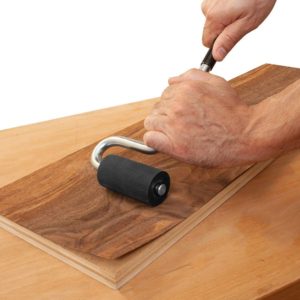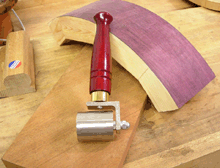What is a Veneer Roller?
A veneer roller, or laminate roller is a basic veneering tool that allows you to apply evenly distributed pressure onto your veneer during glue up. Simple in design, often shaped like a letter ‘J’, hence the name, it has a handle attached to a rolling pin.

Don’t get confused with a glue roller which is used to apply glue evenly to a substrate. A veneer roller is used to press the veneer after it has been placed onto the glue coated substrate to remove air pockets and to achieve maximum adherence between the veneer and the substrate.
Do I really need a veneer roller for wood veneering?
If you are applying and gluing veneer by hand, you will find that a veneer roller will be quite useful for flattening your veneer. It is quite essential if you are using hide glue for example. Because of the thickness of the hide glue, it needs to be pressed or squeezed to a uniform thickness. You need the roller to do that job.
If you are using a vacuum press for your veneer application, you might not really need to purchase this tool. A veneer roller is an ideal tool however for applying pressure to sensitive veneers.
Even if using a vacuum pump, you can still roll flat the obvious bumpy parts that any air pockets have created before putting into the vacuum bag.
Why are there different kinds of veneer rollers?
There are various kinds of rollers that suit the kind of veneer work best. Aside from the cosmetic variations of the handle size and material, the most obvious is the width of the roller. The wider the roller, the more surface area that you can roll or press on at one time. Smaller width rollers do better in tight areas such as corners, but if you have large surface areas to cover, than a wider veneer roller would be best. Typical widths range from one inch, to three inches.
Another variation in the roller is the shape and placement of the actual roller on the handle. You may see a roller called a ‘Jay’ roller for example. This is because the roller is in the form of the letter ‘J’. This is differentiated from the typical veneer roller shape as seen here. ‘J’ shaped rollers allow for more pressure to be applied onto the veneer surface. They are are more typically used for laminate projects due to their larger roller width as well.

Lastly, another variation can be the materials that the veneer roller is made from. Besides the actual handle, sometimes the actual roller material becomes important. For example, when rolling hide glue pressed veneers, a metal roller will help dissipate heat from the glue better, helping the glue set. A rubber roller would not have this effect, although a rubber roller is adequate for other purposes.
Notice that the roller below are almost exactly the same except one roller head is made of rubber, one wood, and the other metal.
Clicking images will open a new window in Amazon and provide more details.
So, just to keep it simple:
Use a veneer roller to apply pressure without damaging the item underneath.
Metal roller – especially used for applying veneer that is being glue with hide glue.
J-roller – the larger length allows for a wider area to be pressed at once. Good for laminate projects.
Traditional roller – used on smaller wood veneer projects, works well in corners and tighter areas.



